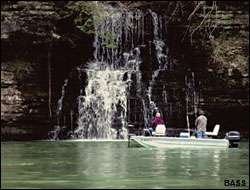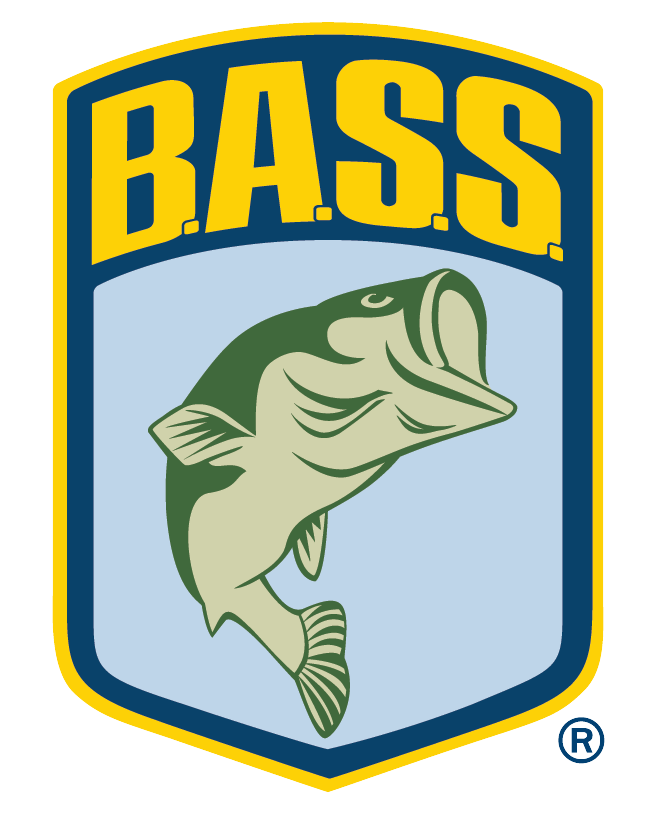
Those lazy, hazy days of summer have a way of slowing life down.
When the heat becomes unbearable, dogs slumber in the shade, plants wilt in the searing sun, sluggish bass cool off by hanging around deep water structure and some anglers retreat to an air-conditioned cottage.
One angler who takes advantage of summer's slowing effects is Ed Hutchison, who once operated a guide service on Lake of the Ozarks."I'm a slow kind of guy anyway," Hutchison says. By using light line, small lures and a hand-retrieval trick, Hutchison has developed a way to catch sluggish summertime bass.
The guide's easygoing manner and his summertime fishing technique match up well with his fast-paced clients. While Hutchison spends nearly 200 days a year fishing, his clients have to cram all their fishing time into a couple of days or sometimes only a few hours. His clients also have embedded in their minds that to succeed in their business world, they must work at a rapid pace.Hutchison's finesse fishing tactic shows the business executives the virtues of working slowly and deliberately."In my business, I often get to introduce people to their first taste of fishing," Hutchison says. "My technique gets them to slow down and helps them catch their first bass."
Before the guide can teach his clients the slowdown method, he has to find the fish first. Many Bassmasters concentrate on the sunken brushpiles at Lake of the Ozarks during hot weather. From the end of June to early September, however, Hutchison finds more cooperative bass along the lake's numerous bluffs.
"Bluffs will hold fish all the time because these structures always occur near a river or creek channel," Hutchison says. He locates the fish on bluff points and any ledges, pockets and fallen trees he can find along the rock walls.
When the water temperature rises from 70 degrees to the upper 80s, Hutchison heads for the bluffs. After finding a suitable location, he positions his boat parallel to the bluff and has his clients fish in the front of the boat with him. By fishing parallel to the rock wall, Hutchison and his clients can keep their lures in the strike zone longer since the bass tend to stay close to the rocks.
Tackling the lures
The hardest part of the process is getting his customers to forget their fast-paced ways and convert to Hutchison's finesse tactics and lures.He favors 4- or 6-inch plastic worms, plastic grubs, soft plastic crawfish and 1/4-ounce jigs tipped with No. 11 pork frogs or small lizards. The plastic baits are rigged Texas or Carolina style with worm weights ranging from 1/16 to 1/4 ounce, depending on wind velocity.Hues he finds most productive include black-and-blue combinations, pumpkin pepper with green or black flake, bubblegum pink, blue shad and natural crawfish or shad.
Small lures work best for the Lake of the Ozarks guide during the summer. Besides, he says, "I'm a firm believer that on any lake in the world, you're going to get more bites on smaller baits."To fish these small lures, Hutchison uses a stiff spinning rod with a light action tip and a spinning reel filled with 6- or 8-pound-test line. The light monofilament allows the small lures to sink to fish that are holding near the deeper bluff ledges.Once he has tied on one of those lures, Hutchison casts along the bluff and lets the bait fall straight down until it lands on a ledge. Most strikes come from suspended bass that hit the lure on the fall. If he's catching fish this way, Hutchison removes the worm weight to make the plastic bait fall slower, increasing his chances for strikes from suspended fish.
When the bait lands on a ledge or large rock, Hutchison lets it lie still for a couple of seconds. If the bait gets hung up, he gently shakes his rod tip to dislodge the lure.The guide's next steps deviate from the standard worm or jig retrieval. Rather than lifting and dropping the rod tip to move the lure, Hutchison keeps his rod close to the 10 or 11 o'clock position and uses a fly fishing retrieve: He pulls the line with his fingers, which tantalizingly crawls the bait along the rocky shelf. The gradual movement of the lure gives even the laziest bass a chance to inhale the bait.
After he pulls 10 to 12 inches of line through his fingers, Hutchison stops his retrieve. If the lure settles on another rock, the guide reels in the excess line. But if the lure continues to drop, he lets the extra line slip through his fingers to allow the bait to fall deeper. Pulling in and releasing his line by hand lets Hutchison crawl a lure up a rock or drop it into a crevice without opening and closing the bail on his reel.This technique catches suspended fish as well as bass hugging the rocks and ledges. By letting his lure continue to fall, Hutchison can also entice any fish hanging around the channel dropoffs. "I've caught fish doing this in 30 feet or more of water," Hutchison says.The Missouri guide retrieves the lure in this fashion about three-fourths of the way back to the boat before reeling in for another slow falling presentation."This is by no means a speed-reeling contest, but I don't take a nap, either," Hutchison says of the process.
Keeping his rod tip high and his fingers on the line helps Hutchison detect subtle strikes. "I'm more in contact with the bait this way and can feel the strikes better," he says. "I try to stay in contact with the bait, whether it's floating or rolling around, and I let the line or my rod tell me if there's a fish on."
Hooking up
Strikes from bluff bass vary. Some merely pick up the bait, while the more aggressive fish inhale the lure and swim away with it. "If I feel something different, I'll jerk it," Hutchison says. What is more, if he loses contact with the bait — an indication a bass may have picked up the lure — he doesn't hesitate to set the hook.Despite having his rod tip up and excess line sliding through his fingers, Hutchison still manages to set the hook on most of his bites. To keep the fish from swallowing the bait, he sets as soon as he detects a strike.His method of hooking bass differs from the rear-back-and-cross-their-eyes hook set of other plastic-worm fishermen. When he feels a tap, he raises the rod to take out the slack and sets the hook with his rod and reel close to his body. He generates power for the hook set through his wrists and arms. "I give it a pretty good jolt," Hutchison says.
The bottom line
One particular mile-long bluff at the Lake of the Ozarks provides plenty of summertime action for the guide and his clients. "I've started at one end of the bluff and caught 40 or 50 fish by the time I've reached the other end," Hutchison says.While the best times to try Hutchison's techniques are mornings and evenings, the guide asserts that bass can be taken as well on those 100 degree afternoons if an angler can stand the heat. Hutchison believes bluff bass remain more active than their brethren that inhabit brushpiles, and they will attack his lures throughout the day.





